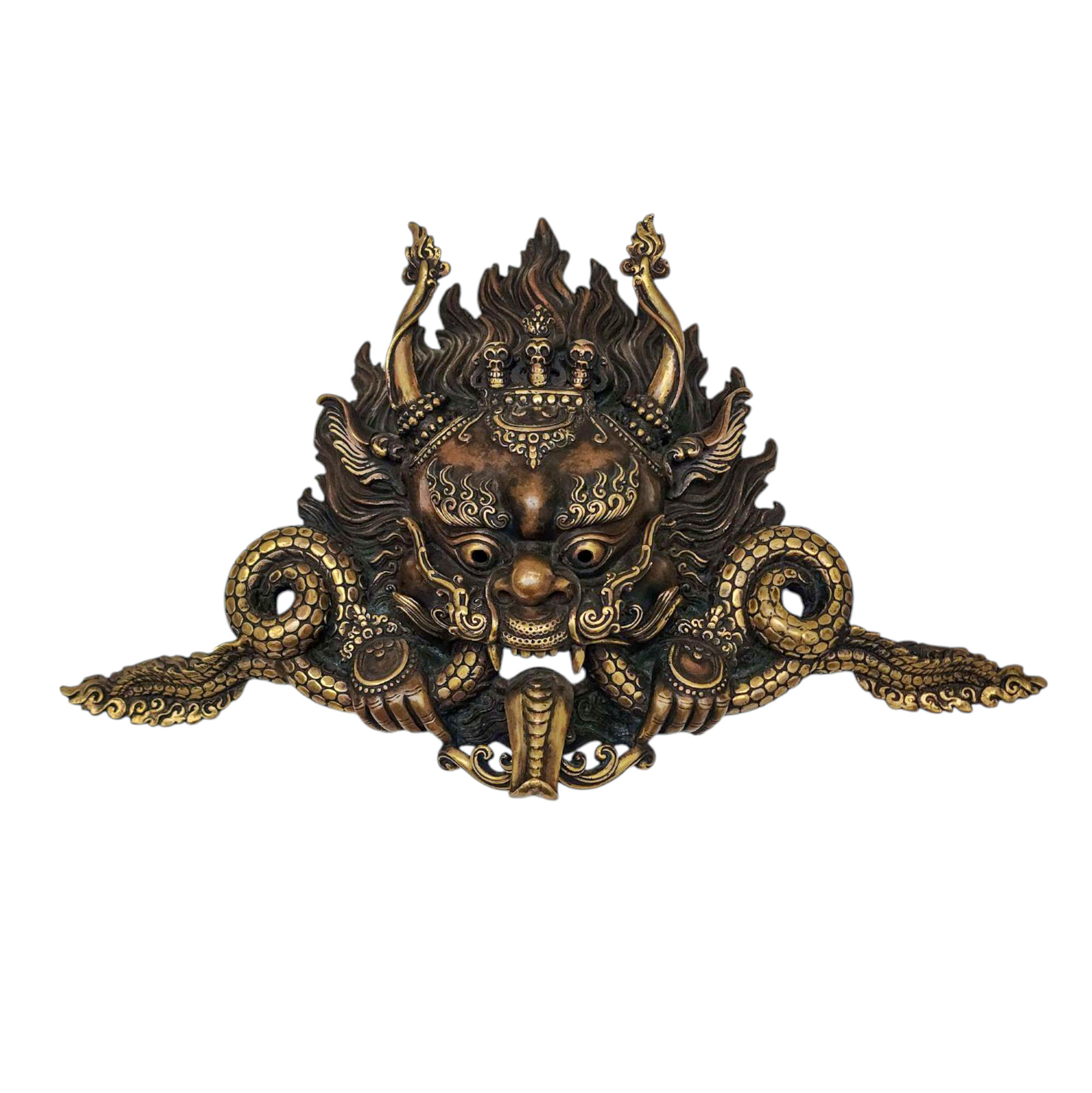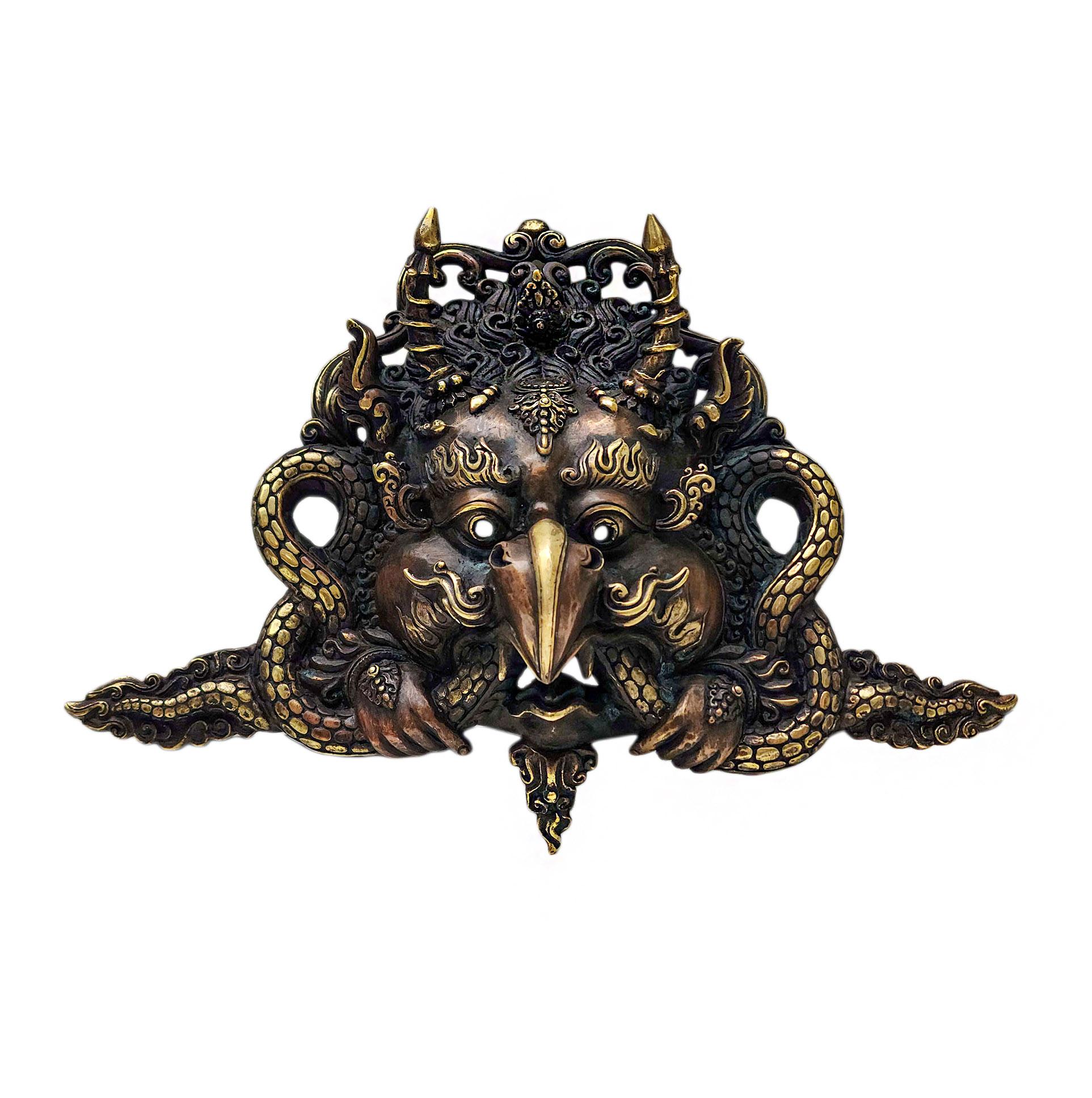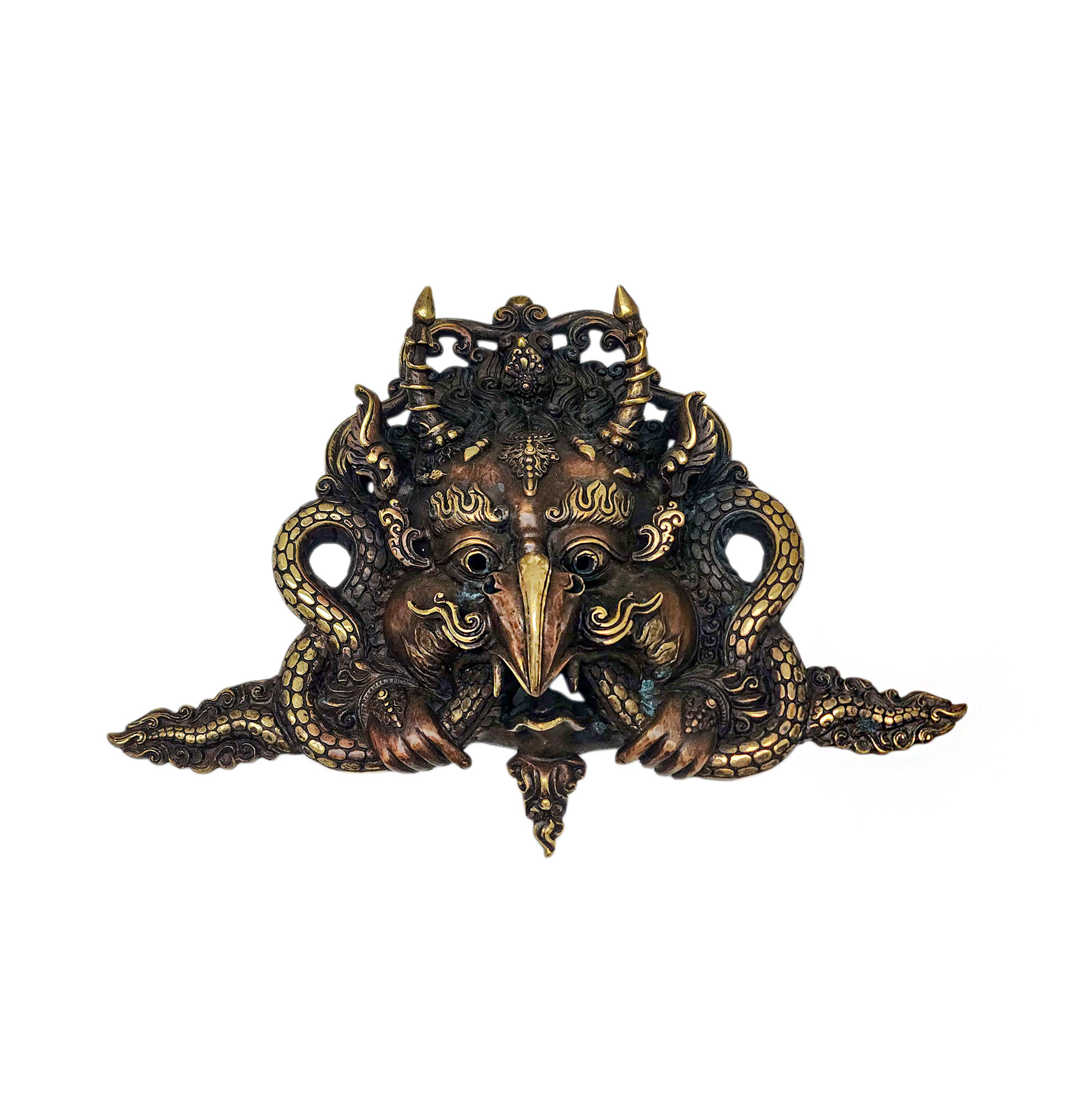Code
HCS35042
Weight
1.19 Kg / 2.62 lbs
Size
Height
25cm (10") Width
37cm (15") Depth
8cm (3") Material
Brass
Availability
Available

Safe Payment
We accept Paypal, Money Transfer, Bank Transfer
Confidence
Protection covers your purchase and personal data.
Worldwide Delivery
We ship Worldwide, except Russia.Shipping cost US$25.2 for upto 0.5 kgs

Hotline
Talk to help line for your question on 9841267335Lost-Wax System
This Metal Mask of [cheppu], Handmade Ritual Metal Mask, Antique Finishing, is made by the process of the Lost Wax system. This is a very complicated, time consuming and historic process of making metal sculptures.Which is why it is sometimes called Precision Casting as well. Hence the sculptures made by this process are comparatively expensive. There are many new, advanced and less time consuming methods of casting metal sculptures available as well. But due to the benefits provided by the traditional lost wax system in quality control and customization, we prefer the Loss wax system over Ceramic molding, or sand casting to make our Metal Mask.
Below we have tried to illustrate the process of making a loss wax system statue: Read More . . .
This Metal Mask of [cheppu], Handmade Ritual Metal Mask, Antique Finishing, is made by the process of the Lost Wax system. This is a very complicated, time consuming and historic process of making metal sculptures.Which is why it is sometimes called Precision Casting as well. Hence the sculptures made by this process are comparatively expensive. There are many new, advanced and less time consuming methods of casting metal sculptures available as well. But due to the benefits provided by the traditional lost wax system in quality control and customization, we prefer the Loss wax system over Ceramic molding, or sand casting to make our Metal Mask.
Below we have tried to illustrate the process of making a loss wax system statue: Read More . . .
Metal Wall Hangings : Brief Introduction
Tibetan Buddhist culture is rich in symbolism and art, and metal or wooden wall hangings are essential to this tradition. These wall hangings, also known as paubhas, are typically made in painting form, painted on a cotton canvas with natural color. they are also made in wood, brass, or clay, and feature intricate designs and vibrant colors. They depict various aspects of Buddhism, such as deities, Buddhist teachings, and spiritual stories. Many of these wall hangings are adorned with semi-precious stones, such as turquoise, coral, and lapis lazuli, which add to their beauty and symbolic significance. Read More . . .
Tibetan Buddhist culture is rich in symbolism and art, and metal or wooden wall hangings are essential to this tradition. These wall hangings, also known as paubhas, are typically made in painting form, painted on a cotton canvas with natural color. they are also made in wood, brass, or clay, and feature intricate designs and vibrant colors. They depict various aspects of Buddhism, such as deities, Buddhist teachings, and spiritual stories. Many of these wall hangings are adorned with semi-precious stones, such as turquoise, coral, and lapis lazuli, which add to their beauty and symbolic significance. Read More . . .
About Chephu :
Cheppu is one among the three siblings Garuda, Cheppu, and Hiti Manga. It is informed that once the mother of these siblings, mentioned her better half to conceive an offspring of such a child who might be the boldest, generally honest, and entitled with every single unrivaled imprint. Her better half advised her to hang tight for a specific period. She being impotency to hang tight for an extensive stretch, looked the home if he was conceived. She discovered Cheppu in a pre-mastered condition just with the arrangement of the head.
Cheppu is portrayed in his fierce appearance eating up showing just 50% of Cheppu's body and eating up Naga(snake).
It is additionally informed that Cheppu vanished from the world as he would not like to see the kaliyuga, the incredible yuga, when the evil would totally victorious over the great and the world would be obliterated by Vishnu in his manifestation as kalki, the destroyer. Knowing his fortitude, honesty and entitled with every one of the better stamps Manjushree needed than see him and mentioned him to show his full structure. He showed up gradually in the midst of the cloud. Manjushree, as a veteran craftsman, quickly drew his structure by his foot subtly without the information on Cheppu. At the point when Manjushree could complete to draw his head just he came to know Manjushree's misdirection and promptly vanished. Because of his valiance, honesty and every unrivaled imprint, he was given the spot at the highest point of the fundamental passage of the sanctums for the assurance from every one of the risks. Nagas(serpents) are the food of Cheppu.
Along the narratives of Manjushree, comes an intriguing and interesting story joined to Cheppu â The Mythical Creature:
Quite a while past, the Kathmandu Valley was just an enormous lake occupied by the endless number of sea-going creatures. Most of them were the Nagas (snakes). Along these lines, this valley was otherwise called Naga Daha, which means the "Home of the Serpents'.
One day Manjushree Bodhisattva (a Buddhist god from China) stayed with this valley. He loved the valley. He loved the valley such a lot of that he needed to make a delightful town out of it . With this aim he promptly slice through the southern slope of the valley with one stroke of this his incredible sword (Chandrahara) and depleted off the water. This constrained every one of the occupants of the lake to leave, as they couldn't do anything against the omnipotent Manjushree. Be that as it may, an animal called Cheppu waited. When by his yogic force Manjushree detected that there was somebody actually covered up some place under the remainder of the lake, he instructed the last to leave the water in a flash. He was frightened when he saw that he was unable to conflict with the force of Manjushree. In this way, he said he would leave the lake if Manjushree would vow not to take a gander at his shocking element when he moved out of the lake. As indicated by the guarantee, Manjushree shut his eyes and Cheppu arranged to emerge from the water. As the dread stricken animal pushed half of his terrible body over the surface, Manjushree couldn't resist the opportunity to open eyes covertly, wondering for no specific reason. At the point when Cheppu saw Manjushree open his eyes, he got so vexed that he immediately plunged back profound under the water to conceal himself once more. Manjushree, embarrassed about breaking his guarantee, before long haggled with Cheppu guaranteeing him that he could never trouble again to seen by anybody). He additionally guaranteed that he would permit him to involve an exceptionally critical spot in the blessed sanctuaries of Nepal (he planned to develop soon in the valley) and stay there half-covered up for eternity.
This story appears to clarify a ton about our engineering custom of showing just 50% of Cheppu's body over the tympanums of the sanctuary entryways. Regardless of whether this legendary story contains any trace of legitimacy or not issue the least. What includes in the social worth it reflects and the creative interest it leaves for the whole gang to comprehend and appreciate.
It is additionally informed that Cheppu vanished from the world as he would not like to see the kaliyuga, the incredible yuga, when the evil would totally victorious over the great and the world would be obliterated by Vishnu in his manifestation as kalki, the destroyer. Knowing his fortitude, honesty and entitled with every one of the better stamps Manjushree needed than see him and mentioned him to show his full structure. He showed up gradually in the midst of the cloud. Manjushree, as a veteran craftsman, quickly drew his structure by his foot subtly without the information on Cheppu. At the point when Manjushree could complete to draw his head just he came to know Manjushree's misdirection and promptly vanished. Because of his valiance, honesty and every unrivaled imprint, he was given the spot at the highest point of the fundamental passage of the sanctums for the assurance from every one of the risks. Nagas(serpents) are the food of Cheppu.
Along the narratives of Manjushree, comes an intriguing and interesting story joined to Cheppu â The Mythical Creature:
Quite a while past, the Kathmandu Valley was just an enormous lake occupied by the endless number of sea-going creatures. Most of them were the Nagas (snakes). Along these lines, this valley was otherwise called Naga Daha, which means the "Home of the Serpents'.
One day Manjushree Bodhisattva (a Buddhist god from China) stayed with this valley. He loved the valley. He loved the valley such a lot of that he needed to make a delightful town out of it . With this aim he promptly slice through the southern slope of the valley with one stroke of this his incredible sword (Chandrahara) and depleted off the water. This constrained every one of the occupants of the lake to leave, as they couldn't do anything against the omnipotent Manjushree. Be that as it may, an animal called Cheppu waited. When by his yogic force Manjushree detected that there was somebody actually covered up some place under the remainder of the lake, he instructed the last to leave the water in a flash. He was frightened when he saw that he was unable to conflict with the force of Manjushree. In this way, he said he would leave the lake if Manjushree would vow not to take a gander at his shocking element when he moved out of the lake. As indicated by the guarantee, Manjushree shut his eyes and Cheppu arranged to emerge from the water. As the dread stricken animal pushed half of his terrible body over the surface, Manjushree couldn't resist the opportunity to open eyes covertly, wondering for no specific reason. At the point when Cheppu saw Manjushree open his eyes, he got so vexed that he immediately plunged back profound under the water to conceal himself once more. Manjushree, embarrassed about breaking his guarantee, before long haggled with Cheppu guaranteeing him that he could never trouble again to seen by anybody). He additionally guaranteed that he would permit him to involve an exceptionally critical spot in the blessed sanctuaries of Nepal (he planned to develop soon in the valley) and stay there half-covered up for eternity.
This story appears to clarify a ton about our engineering custom of showing just 50% of Cheppu's body over the tympanums of the sanctuary entryways. Regardless of whether this legendary story contains any trace of legitimacy or not issue the least. What includes in the social worth it reflects and the creative interest it leaves for the whole gang to comprehend and appreciate.
Cheppu - The Mythical Creature


![[cheppu], Handmade Ritual Metal Mask, Antique Finishing,](https://www.handmadeexpo.com/pics/product/thumb/35042_0.jpg)
![[cheppu], Handmade Ritual Metal Mask, Antique Finishing,](https://www.handmadeexpo.com/pics/product/thumb/35042_1.jpg)
![[cheppu], Handmade Ritual Metal Mask, Antique Finishing,](https://www.handmadeexpo.com/pics/product/thumb/35042_2.jpg)
![[cheppu], Handmade Ritual Metal Mask, Antique Finishing,](https://www.handmadeexpo.com/pics/product/thumb/35042_3.jpg)
![[cheppu], Handmade Ritual Metal Mask, Antique Finishing,](https://www.handmadeexpo.com/pics/product/thumb/35042_4.jpg)
![[cheppu], Handmade Ritual Metal Mask, Antique Finishing,](https://handmadeexpo.com/pics/product/thumb/35042.jpg)



























































 Garuda, Handmade Ritual Metal Mask, Antique Finishing" title="
Garuda, Handmade Ritual Metal Mask, Antique Finishing" title=" Garuda, Handmade Ritual Metal Mask, Antique Finishing" title="
Garuda, Handmade Ritual Metal Mask, Antique Finishing" title="






 Painted,
Painted,  Painted,
Painted,  Sand Casting" title="Ganesh Metal Mask
Sand Casting" title="Ganesh Metal Mask  Sand Casting" title="Ganesh Metal Mask
Sand Casting" title="Ganesh Metal Mask 


